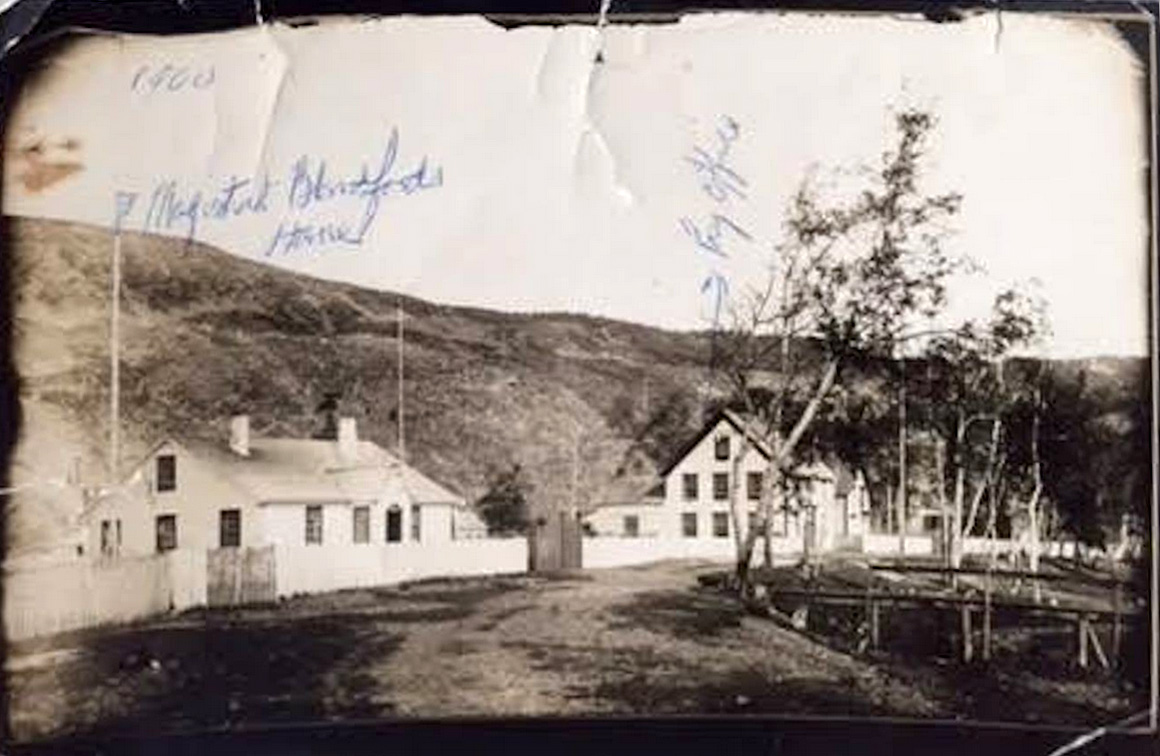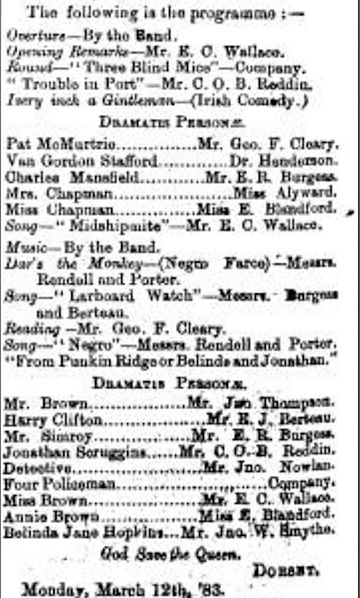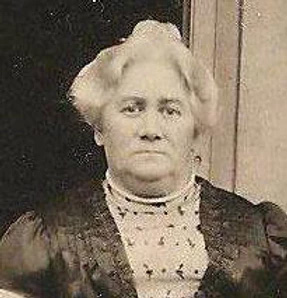 All that remains of the people I cover are scattered references. What follows is an attempt to use a few documents to tell a story and in so doing catch a glimpse of a person’s life. In this case the task is made more difficult by historical patriarchy and the fact that women’s lives were often so poorly documented.
All that remains of the people I cover are scattered references. What follows is an attempt to use a few documents to tell a story and in so doing catch a glimpse of a person’s life. In this case the task is made more difficult by historical patriarchy and the fact that women’s lives were often so poorly documented.
Eliza arrived with her family in 1880. Her father, John Bennet Blandford, had been appointed Magistrate. She was 15 years old the first time she saw Little Bay. As the Magistrate’s daughter she was a member of high society. The Blandfords were expected to participate in public events. This responsibility extended to all members of the household. She was new to this frontier town, the town itself was new and still lawless. Her family had come to tame it, to domesticate it. She’d likely have understood what was expected of her there.
The social scene in Little Bay was diverse. There were large public events that could involve the whole population of the town. These would usually celebrate visiting dignitaries or recognize royal events. Such days could see the mine shut down and cease activity so that everyone could enjoy the festivities. While the holidays given for these day-long, town-wide events were infrequent, other activities were not. The entertainment options were varied with sports, dances, debates, lectures, concerts, plays, readings, public meetings, and bazaars all happening quite regularly. There were a variety of venues for public events and evenings of entertainment could be found at the churches, schoolhouses, Masonic Lodge, Skittle Alley, or the Little Bay Hotel. The town’s cultural hub, however, was undoubtedly Little Bay’s Public Hall. My first reference to it appears in the Twillingate Sun in February of 1882 in an article covering the first public performance of the Little Bay Choral Society. It most likely opened in 1881.
 The Public Hall was expanded upon in August of 1883 when, under the leadership of Presbyterian Rev. Fitzpatrick, the Reading Room was added. It’s important to note that Rev. Fitzpatrick is also credited with starting the town’s Temperance Movement and the Reading Room was subsequently owned by the Norte Dame Total Abstinence Society. The connection between literacy and temperance is relevant. Reading was held in contrast to cricket as a result of the laters association with drinking. In letters to the editor complaints about cricket were framed against the Reading Room. The town would go on to take pride in its literacy with a public announcement once every home in the community could claim a bookshelf. Eliza Blandford like all members of the Blandford family was involved in this as part of the town’s Temperance movement.
The Public Hall was expanded upon in August of 1883 when, under the leadership of Presbyterian Rev. Fitzpatrick, the Reading Room was added. It’s important to note that Rev. Fitzpatrick is also credited with starting the town’s Temperance Movement and the Reading Room was subsequently owned by the Norte Dame Total Abstinence Society. The connection between literacy and temperance is relevant. Reading was held in contrast to cricket as a result of the laters association with drinking. In letters to the editor complaints about cricket were framed against the Reading Room. The town would go on to take pride in its literacy with a public announcement once every home in the community could claim a bookshelf. Eliza Blandford like all members of the Blandford family was involved in this as part of the town’s Temperance movement.
Eliza was a lady of Little Bay’s high society. The Public Hall was hosting concerts and plays regularly by 1882 and Eliza, then 17, was on its stage. She was a regular performer. My first reference to the Public Hall comes from that February where, as a member of the Little Bay Choral Society she performed a duet called “Polly Hopkins and Tommy Tomkins” with Mr. Berteau. I suspect this was her first performance as the reporter criticized her saying it “would have been far better if Miss B. had governed her laughing propensities” (TS Feb 1882). That same article also praised her, however, for her piano playing after she accompanied Dr. Stafford in his rendition of a song called “Consolation” for which he was said to have a capital voice and the knowledge to use it. Perhaps he impressed her. Dr. Stafford was to be her future husband. She also sang a duet of “Two Merry Girls” with Miss Winton at that show. I can place her again on the stage there in February of 1883 when she performed a piano duet with her sister and also sang a song called “Those Awful Boots” with Mr. Burgess, Mr. Berteau, and Mr. McLeod (TS Feb 1883). One month after that she was acting. In March she played Miss Chapman in the Irish Comedy “Ivery inch a Gintleman” and Annie Brown in the play “From Punkin Ridge or Belinda and Johnathan” (TS March 1883). By 1885 she was taking on further responsibility and could be found serving as the secretary for the Fancy Fair (TS June 1885).
 She likely had a function at the Church of England Bazaar which was held in the Skittle Alley in October of 1885 but what was talked about after that evening was her popularity. It was written that “Perhaps the most exciting event of all was the voting for the most popular young lady in Little Bay. The three favourites were Miss Blandford, Miss Duder, and Miss Ross. Just before the poll closed excitement became intense and each young gentleman was determined to elect the lady of his choice. When the poll was finally declared it was found that Miss Blandford was elected by an overwhelming majority” (ET 1885 Oct). I deduce from this that she was beautiful.
She likely had a function at the Church of England Bazaar which was held in the Skittle Alley in October of 1885 but what was talked about after that evening was her popularity. It was written that “Perhaps the most exciting event of all was the voting for the most popular young lady in Little Bay. The three favourites were Miss Blandford, Miss Duder, and Miss Ross. Just before the poll closed excitement became intense and each young gentleman was determined to elect the lady of his choice. When the poll was finally declared it was found that Miss Blandford was elected by an overwhelming majority” (ET 1885 Oct). I deduce from this that she was beautiful.
She was smart too. One of the biggest events that ever took place in Little Bay was the celebration of the Queen’s Jubilee and Eliza Blandford was one of the people who organized it. She was placed on a twelve person committee overseeing the festivities of the Queen’s Jubilee in August 1887. “It was formed by the various clergymen of the place naming four persons, two ladies and two gentlemen. [. . .] The gentlemen constituted themselves into a committee to provide field sports, and the ladies into one to provide the eatables and drinkables. Both endeavoured to give expression to the idea of Mr. Blandford, and they succeeded to a charm” (ET 1887 Aug). Eliza at the age of 22 played a vital and prominent role in the organizing of Little Bay’s largest cultural event, she’d started with small roles on the stage in performances at the Public Hall but had continued to expand on her responsibilities. She was an important player in the culture of the town.
The following year, at the age of 23, Eliza married Dr. Stafford. The couple left Little Bay for Twillingate. What’s really unfortunate was her timing as the years immediately following her departure saw Little Bay visited by two prominent 19th century feminists – Jessie Ohman in 1889 and American feminist Lurana Sheldon in 1890. Both women were prolific writers. I imagine Eliza would have liked to meet them there. Jessie Ohman was the leading feminist in late 19th century Newfoundland. She visited the town as a representative of Newfoundland’s Temperance Movement and wrote glowingly about Little Bay in her publication “The Water Lily” in 1892. When this visit was addressed in the newspaper it was reported about favourably with her and her efforts held in high regard. If there was backlash against the expanding role and power of women in Little Bay I have yet to find it. I’m not claiming it didn’t exist but what little is documented is framed by its benefit to the Temperance effort.
I must point out, however, that the involvement of women in this society was severely under documented and what few examples I have required massive accomplishments such as Mrs. Elizabeth Burgess snowshoeing all the way from St. John’s, Miss. Elizabeth Pilgram saving a whole ship singlehandedly, or when Miss. Boyde saved her father’s life from drowning. I know that Miss Boyde was directly involved in the Boyde family business only because of this act and they still neglected to mention her first name. I suspect it was Adelaide. Eliza Blandford found the exceptions to this rule. It would appear that the role of women at the Public Hall, where during concerts and plays at least, they could be given near-equal stage time and praise. The other was under the banner of Temperance, which in Little Bay, considered literacy a sign of victory over alcohol. They succeeded in banning alcohol and made sure everyone had a bookshelf so I’d say they did alright.
Eliza had a son named Bennett who would go on to become a popular figure in Newfoundland for his chain of drugstores. I guess she raised him well. I don’t know how involved Eliza was in the family business but I expect quite a bit. My hunch is women of this era, especially in the upper class, had a much larger hand in things than they are credited for and I think it’s pretty clear that Eliza had a lot to offer any social endeavour. She was bred for it.
 Little Bay was a microcosm for the society at large with the Temperance Movement contributing to the rise of Feminism and an increase in literacy and social power for women. Eliza benefitted from that. She further benefited by the station she was awarded by luck of birth and the opportunities of Little Bay’s active performance culture. This combination led to her being better documented than most women of her day, but she is an exception. I’ve done my best to draw this story out of too few references. In introducing you to Eliza and her role in Little Bay’s high society I’ve hopefully demonstrated how much she accomplished. Her story is further an example of how difficult is it understand women’s lives in that time. Their stories are too poorly documented and we lose something from that, even if we never realize that something was missing. It’s difficult to connect with a past you know nothing about. Eliza is worth knowing about. I hope this helped. Thanks for reading!
Little Bay was a microcosm for the society at large with the Temperance Movement contributing to the rise of Feminism and an increase in literacy and social power for women. Eliza benefitted from that. She further benefited by the station she was awarded by luck of birth and the opportunities of Little Bay’s active performance culture. This combination led to her being better documented than most women of her day, but she is an exception. I’ve done my best to draw this story out of too few references. In introducing you to Eliza and her role in Little Bay’s high society I’ve hopefully demonstrated how much she accomplished. Her story is further an example of how difficult is it understand women’s lives in that time. Their stories are too poorly documented and we lose something from that, even if we never realize that something was missing. It’s difficult to connect with a past you know nothing about. Eliza is worth knowing about. I hope this helped. Thanks for reading!
